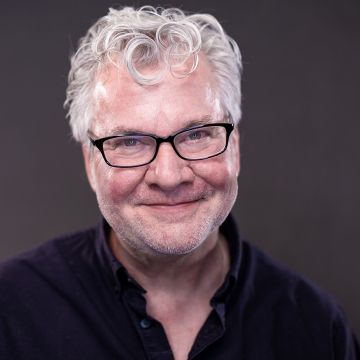Twenty years ago, executives laughed off improvisation as entertainment. Today, Fortune 500 companies, top business schools, and even the FBI bring in The Second City for lessons in thinking on your feet and communicating under pressure.
Kelly Leonard, Vice President of Creative Strategy, Innovation, and Business Development at The Second City and author of Yes, And: Lessons from The Second City, has spent years honing the insight that the improvisational skills comedy requires are the ones executives need most.
"We are living our business lives without a script,” says Leonard, who during his tenure at Second City has discovered and developed talents like Tina Fey, Stephen Colbert, and Amy Poehler. “The only constant is change, so the ability to be agile in groups is one of the most important skills a person can have.”
The power of “Yes, And”
At the center of Second City’s approach is the improv principle of “Yes, And.” The classic exercise finds participants pairing up and pitching ideas to each other in three rounds. First, one person says “no” to every suggestion. Then they say, “yes, but …,” which Leonard calls “no with a top hat.” Finally, they “Yes, And” each other and build on every idea that comes up.
“At Second City, that is the first four weeks of a process for creating a new show,” Leonard says. “We put up every idea. It doesn’t matter how silly, how dumb, how offensive, we are going to try it out, because what we know is you need thousands of ideas to get to some good ideas.”
Importantly, “Yes, And” isn’t about blind agreement. It’s about creating what Leonard calls “a space of abundance.” The exercise works against what behavioral economics has shown is people’s default position: to say no or do nothing. Business leaders can see the exercise as a collaborative practice that can raise team ownership and buy-in during difficult transitions. This leverages the well-studied “IKEA effect” that increases commitment when people help build the plan.
At the same time, not every conversation allows for agreement. That’s where a related technique—“Thank You, Because”—comes in. Developed with Nobel Prize winner Richard Thaler and other behavioral scientists at the University of Chicago, it asks participants to engage in a low-stakes disagreement (Pepsi versus Coke, cats versus dogs), but rather than trying to convince each other, they respond by thanking the other person and naming something of value in what they said. “It’s not about changing your opinion, it’s about listening,” Leonard says.
By rehearsing with harmless topics, teams build reflexes, but the stakes rise by iteration and move into more pressure-driven scenarios where the same strategies de-escalate conflict and clarify messages. “It’s a move that reduces defensiveness while keeping your position intact during tense community briefings or Q&As with the media.”
“Just doing that—‘Thank You, Because’—changes the conversation completely. What everyone discovers is that they end up learning more about this person and actually finding some common ground without forcing consensus. In polarized environments, that small shift nudges each side out of their own headspace and keeps the dialogue alive.”
Building skills to think on your feet
Many of the forces holding us inside our own heads are built into our culture, Leonard notes. “For leaders, one of the biggest challenges is your past success,” he says. “You want to run the same winning playbook over again.”
Also critical, COVID and screen-mediated life have atrophied our tolerance for real-time human interaction. Leonard points to young professionals who are experts communicating across social media and gaming environments who then face crippling self-doubt in traditional work contexts.
Improv exercises help build flexibility. In one called “Point and Untell,” participants point at objects while their partner’s task is to name anything except what it actually is. “Point at an air conditioner, but see if you can say ‘blueberry,’” Leonard says. “It seems simple but it’s surprisingly hard because our brains are incredibly anchored on that one word.”
The exercise forces your brain to bypass what seems obvious. With practice, finding alternatives becomes easier as you start to see past the first answer and become more comfortable in areas that are fuzzier and riskier.
The skill is especially important during a crisis. Under pressure, most people fall back on the most obvious responses and get trapped in tunnel vision. “One of the things that’s crucial in a crisis is the ability to tap into the plasticity of our brains,” Leonard says. “We’re most comfortable when we can establish a pattern. The pattern feels true and we want to stay with that pattern. But the world doesn’t operate like that.”
By building risk tolerance safely, leaders can experiment and get feedback while developing muscle for generating new options under pressure that counter anchoring bias.
Leonard has worked with organizations from the FBI’s hostage negotiation team to senior law enforcement through the University of Chicago Crime Lab teaching the same principles. “The difference is they teach it out of the textbook,” he says, “and we teach it embodied. That means starting with yourself, working on your breathing, getting comfortable in a room, getting out of your head, and then you work to build genuine contact with the person across from you, whether through ‘Yes, And’ or ‘Thank You, Because.’”
“We’re very focused on facts today,” Leonard adds. “We believe facts provide the answer, and often they do, but they are meaningless unless you can communicate them in a way that gets other people to listen.” In a hostage negotiation or a boardroom crisis, having the right answer doesn’t matter if you can’t deliver it in a way that resonates.
By the same token, in crises, leaders often have to communicate clearly and confidently even without complete information. These exercises prepare them for this by training the physiological and cognitive circuits used under stress. Techniques like “Yes, And” and “Thank You, Because” replace our instinctive “no” reflex with practices that maintain dialogue even in polarized situations.
Learning to lead without a script
For business leaders who need to deal with disruption, crisis, and critical buy-in, Leonard joins other communication and business experts to teach Brand Resilience: Crisis Communication for Senior Leaders at the University of Chicago Booth School of Business Executive Education. The hybrid course combines strategic communication training with Second City improvisation techniques to prepare executives for high-stakes situations from boardroom debates to public media interviews. This intensive course teaches senior leaders to communicate decisively, credibly, and confidently in times of turbulence.
“One of the things that excites me about teaching this course is introducing people to the power of improvisational practice as a business strategy,” Leonard says. “In most cases, it only takes about fifteen minutes for the collective light bulb to go off as people realize how little they practice the skills that are so important to their work success: listening, adapting, communicating.”
The unique course includes a pre-course online orientation, an intensive three-day in-person training in Chicago, and a personalized post-course consultation. Participants learn to craft memorable messages, navigate organizational change, and develop crisis communication plans while building the improvisational agility to handle whatever comes next—all while networking with top leaders and experts.
“It’s a gift to be able to help people actualize a skill set that they didn’t know had become atrophied,” Leonard says. “Work drums a lot of creativity out of people. I see my job as helping people reclaim their creative selves.”

A Unique Course That Can Shape Your Effectiveness as a Leader
Designed for today's leadership challenges, this hybrid course trains you to be the calm in any storm. Earn a UChicago credential and network with experts in the field.
Learn more




